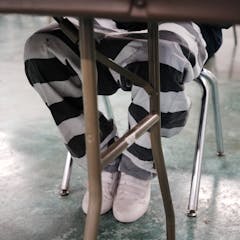
Articles sur Jails
Affichage de 1 à 20 de 31 articles

Only 218 programs offer credit-bearing college programs in prison. That’s about to change.

Most people leaving prison face an uphill battle of service navigation that is too often deficit-focused, intentionally seeking out the failures of the individual and centred on punitive responses.

For Mother’s Day, we look at the fastest growing prison population in Canada — racialized women, many of whom are mothers. Experts connect the trend to rising poverty and the attempts to cope with it.

Experts still disagree about why the US prison population has grown so much over the last few decades. But crime is only one part of the problem.

Prisons and jails have a long history, but they weren’t always used for the same kinds of punishment.

A quarter of prisoners report a cognitive, intellectual or developmental disability. But the true figure could be even higher.

For the 6.5 million Americans who have an incarcerated family member, COVID-19 has made an already stressful situation much worse by drastically limiting communication and raising fears of death.

Infection rates of COVID-19 have soared among prisoners in the US. An expert on penal policy considers what is ‘unjust and disproportionate’ punishment at this time.

Coronavirus infections in prisons are a public health problem for everyone, not just prisoners and sfaff.

Amid the COVID-19 pandemic, missteps in transitioning the incarcerated back to their communities places this already vulnerable populace at greater risk of getting and transmitting the virus.

About half of incarcerated women in the United States are mothers to children under age 18. Natural spaces within a prison can help maintain their mother-child bonds.

Half of incarcerated individuals have either a chronic medical or a mental health condition. But social distancing and rigorous hygiene are unattainable for many US jails and prisons.

In the 1790s, penal reformers rebuilt America’s squalid jails as airy, hygienic places meant to keep residents – and by extension society – healthy. Now they’re hotbeds of COVID-19. What went wrong?

What does it mean to hold a party in a place with a long history of death and suffering?

People in jail kill themselves at a rate 3.5 times higher than that of the general population.

Evidence from Scotland reveals the presumption against shorter sentences has shown little reduction in prison numbers.

The politically and emotionally charged court of public opinion is not the place to make policy changes in areas as complex as corrections.

Just as with so many other criminal justice policies, pretrial detention disproportionately affects African-American men and women, destabilizing black families in the process.

The University of Michigan’s Pulitzer Prize-winning historian Heather Ann Thompson explains why Americans must demand better access to the nation’s prisons.

The number of prisons in the US swelled between 1970 and 2000, from 511 to nearly 1,663. Here’s the story of why one town in Arkansas welcomed a correction facility.
